



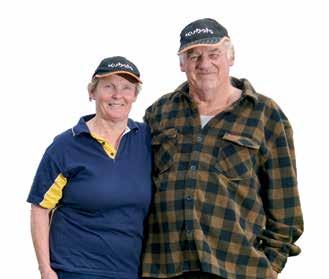


















FONTERRA FARMERS are being told to brace for another carbon emissions target.
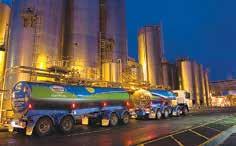
The scope 3 emissions target encompasses carbon emissions that are not produced by Fonterra itself, but by those that it’s indirectly responsible for – including farmers.
Before the end of the year, the cooperative board and management will be out discussing the target with its farmers.
Fonterra chief executive Miles Hurrell told the co-op’s annual gen eral meeting that it was sending “an early signal today that the co-op is considering setting a target for scope 3 emissions”.
“Before the end of the year, we will be out discussing the target and what the flow-on effect for farmers might mean.
“We can’t go into that detail until a target has been identified, but I can explain the rationale for it.
“In short, it comes down to us collectively meeting the climate change expectations of our stake holders, and the risk if we don’t.”
Now that Covid-19 restrictions have largely been lifted, Hurrell and board chairman Peter McBride have been spending time in key markets.

Hurrell says the subject that dominates conversations with cus tomers and debt capital providers is sustainability.
“Our high value customers are setting emissions reductions tar
gets and looking for our help. If we can’t give them confidence that we will help them achieve their targets, they will look to our competitors –including using alternatives to milk.”
McBride says, from his perspec tive, setting a scope 3 target will help Fonterra to maintain compet itive access to some of key interna tional markets.

He points out that the EU has proposed a carbon border adjust ment tax on certain carbon-inten sive goods.

“They are subject to a carbon emissions price via the EU’s Emis sions Trading Scheme.
“Agriculture is not currently in scope, but it is possible it will be brought into the scheme. Others
will follow.
“I expect these types of trade bar riers to become more frequent as international governments respond to their own climate commitments.”
McBride says it’s important that Fonterra gets ahead of them early. He points out that these changes are not just compliance.
“They are an opportunity for us to leverage our natural advantages.
“Despite the very real challenges we as farmers have in front of us today, the board remains confident and excited by the future prospects for our co-op and New Zealand dairy.”

KISSUN sudeshk@ruralnews co nz
“In short, it comes down to us collectively meeting the climate change expectations of our stakeholders, and the risk if we don’t.”Fonterra chair Peter McBride (right) and chief operating officer Fraser Whineray at the annual general meeting in Rotorua last week.
Peter McBride hopes the Government reaches a decision on its new capital structure before the end of the year.
As 100 Fonterra farmers gathered for

its annual meeting in Rotorua last week, the primary production select committee released its report on the legislative changes to the Dairy Industry Restructuring Act (DIRA).
McBride says it’s another key milestone in the legislative process.
“We remain hopeful
that the Government will reach a decision before the end of the year, after which we will move to the Flexible Shareholding structure as fast as possible.”
In the past few years, the co-op has moved its strategy away from a global-volume play to a focus on deriving value
from sustainable New Zealand milk.
McBride says that strategy is starting to deliver – as demonstrated by this year’s milk price and earnings performance.
“Our customers are at the heart of our strategy.
“We will achieve our performance targets by
continuing to deliver products to market in a way that meets their changing expectations.”
McBride told the meet ing that 73% of global consumers find sustain ability pledges important when buying dairy prod ucts.
He says it’s great news for a co-op that’s strat
egy is focused on New Zealand milk and being a leader in sustainability.
“New Zealand dairy farmers already have the world’s lowest carbon footprint.

“If we can maintain that advantage, we have an excellent opportunity to build mutually benefi cial relationships with our
premium customers.
“Maintaining a sustain able supply of that New Zealand milk, in an envi ronment where we expect the country’s total milk volumes to decline, has been a key priority for board and management over the past few years.”
@dairy_news facebook com/dairynewsFONTERRA IS signalling to farmers that it may not meet its earlier pledge to return $1 billion to sharehold ers and unit holders within two years.
Speaking at Fonterra’s annual meeting last week, chair Peter McBride revealed that any amount of any capital return will be determined by the successful divestment of assets, as well as the co-op’s financial position at the time.
As part of its strategy to 2030, Fonterra set a goal of a return of about $1 billion to shareholders and unit hold ers from divestments, including Chilean business Soprole and a stake in the Australian business.
But after looking at options, Fonterra has decided to maintain full ownership of the Australian business.
Part of the 2030 strategy includes pumping $1 billion each into sustainability and moving milk into higher value products.
McBride says the co-op is still committed to invest ment targets for sustainability, higher-value products and R&D.
However, he points out that return to shareholders and unit holders had anticipated divestments including Sop role and a stake in the Australian business.
“Even though we have since decided not to sell a stake in our Australian business, we are still committed to tar geting a significant capital return to our shareholders and unit holders.
“We need to be mindful that we retain the asset in Aus tralia, and the earnings associated with it. The amount of any capital return will be determined by the successful completion of the divestment programme as well as the co-op’s financial position at the time.” – Sudesh Kissun
NEW FONTERRA Co-oper ative Council chair John Ste venson says there are plenty of challenges ahead for Fonterra farmers.
The Wairarapa farmer, who took over the chairmanship at the co-op’s annual general meet ing last week, says he’s looking

forward to the challenge.
“There are plenty of chal lenges ahead: our co-op is in a strong position and it’s impor tant our farmers have a voice,” he told Dairy News
“I’m excited with this oppor tunity to represent farmers.”
Stevenson replaces James

Barron who retired after three years in the role.
He was first elected to the council in 2017 from the Wair arapa ward. A fifth generation dairy farmer, he has been milk ing cows on the family farm for 12 years.
Stevenson owns two farms: a
1,000-cow farm in Carterton and a 500-cow farm in Masterton.
He is currently chair of the council’s accountability com mittee. He was part of the DIRA working group in 2018-19 and currently serves as a council rep resentative on the board’s cooperative relations committee.
Council’s new chair, Pamela Storey, says the relationship between the council and farmers in the region has improved over the past three years.
Storey took over the chair’s role late last month after a tight race for the position between Storey and fellow council lor Stu Kneebone.
While Storey and Kneebone tied for the position in the initial vote, it was decided when Sto rey’s name was pulled from a hat.
This is Storey’s second term as a councillor: pre vious roles included chairing Dairy Women’s Network and spending 20 years in various gover nance roles.
“Local government is different,” she told Dairy News. “I suppose that when you join council for the first time, it is a very steep learning curve… first of all, the depth and breadth of the work that the Regional Coun cil does, that is consider able.”
Storey says that unless you’re a person who
has interacted with all of the different parts of the council previously, you won’t necessarily be aware of all the work the Regional Council does.
She adds that under standing the legislative framework under which council operates can take time as well.
During her last trien nium (three-year term) on the council, Storey chaired the strategy and policy committee.
“Chairing that allows you to develop some skills around how you chair 14 councillors through discussion and debate, but it also allowed me to really immerse myself in that policy development space, including making submissions on central government direction.”
From Storey’s perspec tive, both as a council lor and as a dairy farmer, the relationship between Waikato Regional Council and the region’s farmers has improved in the past three years.

“I think inevitably there is going to be some tension because of the regulatory environment that the WRC operates,” she says.
“That tension isn’t just
every region, rarely does one size fit all.
positive work that’s hap pening in the catchment space.”
She says that one of the most important things is ensuring that council is working alongside farmers during times of regulatory change.

Storey says the most significant issue that will impact farmers this trien nium is the Government’s freshwater package.

The freshwater regu lations require farmers who graze livestock on an annual forage crop over winter and do not meet a range of permitted activ ity criteria to gain a certi fied freshwater farm plan or apply for a resource consent from 1 Novem ber 2022.
She
“We are where the rubber hits the road in terms of giving effect to these proposed changes,” she told Dairy News
with farmers, it’s with everyone that operates within the resource space and interacts with the council in terms of com
pliance.”
Storey says this inevitably causes tension.
“Local councils are required to deliver on those national policies and how this region is affected by those proposed policies is unique as it is with
She says she sees those tensions across a number of sectors, not just with farmers.
“So… from my perspective, ensuring that the Waikato voice is reflected loud and clear during the government policy development process, that to me is very important alongside ensuring quality engagement with the farming community when we are finally tasked with delivering on whatever central government directions, wherever they land.”
good practices and sup port where we’re able to, and that includes help ing farmers to get fund ing to support some really
Storey says initial con versations with communi ties in the Waikato region kicked off in the last tri ennium, now the issue is progressing the policy development to ensure the policies are “as simple as possible for those that have to implement them”.
She says that while there are time constraints in place, the current ques tion before council is how to have effective conver sations with communities during the policy develop ment phase.
“But as an example, I think we’re putting a great deal of effort into enabling farmer produc ers to continue to developWAIKATO REGIONAL Council chair Pamela Storey says poli cies from the central Govern ment have a significant impact on the relationship between local government and farmers. says that this is mainly because local government is the one to enforce certain regula tions.
“And so, inevitably, when we talk to people that might be impacted by central government direction, they think it’s coming from us, so they think that it’s originating from the regional council and that’s not the case.”


take
the pressure off farmers and give them more time to properly understand and digest the huge raft of changes that the Gov ernment is trying to push through before next year’s

"Hassle free travel for mature travellers’’
• FAR NORTH & BAY OF ISLANDS (4 spots available)
7 days, depart 17 September. A leisurely coach tour of the Far North including the new Hundertwasser Art Centre and day trip to Cape Reinga.
• EAST COAST & NAPIER (6 spots available)
8 days, depart 21 September A unique and exciting tour around the East Cape and return via the Northern Explorer train
• CHATHAM ISLANDS DISCOVERY
8 days, depart 20 October A special place for a safe and relaxing close to home all inclusive holiday.
• BEST OF THE SOUTH ISLAND 15 days, depart 22 November A spectacular trip around the many highlights of the South Island taking in the wonders of Tekapo, Twizel, Stewart Island day excursion, the Milford Sound and Queenstown. Overnight cruise on the Milford Sound
• NEW PLYMOUTH 'CHRISTMAS LIGHTS' 5 days, depart 23 December A Christmas get away featuring the magnificent light display at Pukekura Park along with some great sightseeing during the trip.
• WAIKIKI BEACH & HAWAII CRUISE
11 days, depart 25 May 2023 A 'Pride of America' cruise for 7 nights with a Waikiki highlights 3 day stop over including Pearl Harbor and Oahu round Island tour.
• TAHITI & SOCIETY ISLANDS CRUISE
10 days, depart 21 July 2023 Set sail on board Le Paul Gauguin for an unforgettable journey to discover idyllic sands and atolls. Tour includes flights to/from Papeete.
For full details

Phone 0800 11 60 60 www.travelwiseholidays.co.nz
election. Ben Allomes told Dairy News that the Gov ernment has a number of things they want to achieve before the next election and he says most of these seem to be aimed at the primary sector.
These include green house gas emissions, water quality, animal wel fare and labour.
Allomes says this is on top of farmers trying to deal with the uncertain ties around Covid, such as disrupted supply chains and increasing costs, all of which are creating an uncertain business envi ronment.
He says, as well as trying to run their busi nesses, farmers are being asked to read massive documents and then give
feedback.
“This is consultation at scale and at pace. It is overwhelming and unre alistic for us to be able to give honest demo cratic feedback on every piece of legislation that they are working on the moment. It is democracy by stealth,” he says.
Allomes says the prob lem is that so many of the proposed changes are very complicated and it’s not possible to draw up a simple one page summary of what’s involved.
He says the problem is compounded by the bureaucratic way the doc uments are written and the lack of answers pro vided in some of them.
“I know that we have to pay the piper at some
stage. We have got to do our bit, but when it feels unfair, disorganised, unevenly balanced, to the point we feel we are car rying the load of soci ety with untested science and unknown information they are creating along the way, how can you gen uinely feel consulted?
“How can you genu inely believe and trust what they are trying to do is absolutely good for us and society? In my view some of the changes will result in perverse out comes on our businesses, our communities and the environment,” he says.
Allomes says he’s changed his business mas sively in the last ten years to become more environ mentally and socially sus
tainable.
But he contends it takes time and capital and is a long game being played which has impacts way beyond the farm.
“As farmers we have to do our bit and I get upset when farmers try to defend the line of how we used to do things.
“We have to expect and demand change our selves, because the way we farmed in the past is not fit for purpose for the future.
“The problem is that some people are trying to protect our past rather than looking forward and embracing the new future. But that new future to many of us does not seem fair and equitable and one that will serve future gen
erations,” he says.
According to Allomes, farming today is exponen tially much harder than it was ten years ago.
He says, just to achieve what he was achieving 10 years ago takes more head space and energy because there is more recording of compliance, labour, animal welfare and other issues. He says it’s also hard to get an accu rate assessment on some of the changes with dif ferent assessments of the changes being put out by lobby and industry groups.
For Allomes, the objec tive as a farmer is to pro duce good and sustainable food and he doesn’t hold to the view that NZ should be some sort of ‘food bowl’ for the world.
But he says farmers get confused when, on the one hand they are being asked to reduce their emissions, then the Gov ernment welcomes and celebrates the arrival into NZ of 220 cruise ships. He says in the light of such contradictions and mis information, farmers lose trust and get suspicious of change.
“My message to Jacinda would be, ‘give us the time to let the dust settle and reshuffle our deck to understand what level of resource we need now to run our operating systems going forward,” he says.
2001 to around 78% in 2021.
DAIRY WORKERSwarn that if Fonterra’s capital structure isn’t changed there will be fac tory closures and job losses.
In its submission to the parliamentary pri mary production select committee last month, the Dairy Workers Union (DWU) threw its support behind changes to the co-op’s capital structure passed by farmer share holders one year ago.
The changes require amendments to the Dairy Industry Restructuring Act (DIRA) by Parliament.
While the Govern ment has signalled that it intends to approve the changes, there’s strong opposition from rival pro cessors.
Last month the select committee heard submis sions in Wellington. Its report was due out last week.
In its submission the DWU says it strongly believes that the future strength of the NZ dairy industry requires the pro posed amendments con tained in the Bill.
The DWU has mem bers at over 70 dairy man ufacturing sites in the country: around 6,000 DWU members work for Fonterra and another 2,500 workers with other industry stakeholders.


It points out that over the last 20 years Fonter ra’s raw milk market share has reduced from 96% in
“Most dairy industry analysts project Fonterra’s market share will reduce further to just over 70% by 2025,” it says.
It is concerned that without the changes pro posed by the Bill, Fon terra runs the very real risk of under-utilisation of existing assets and the prospect of local ised or regional job losses through partial or full plant closures.
The DWU submits that without these proposed DIRA changes, “exist ing well-paid and highly skilled Fonterra dairy processing jobs may be lost from a provincial or regional area, only for a new dairy employer to become established only several kilometres away, offering substantially lower wages and reduced industry conditions to those offered to current workers”.
“The DWU is also con cerned that without the proposed changes to Fon terra’s capital structure, we may well see the clo sure of many current Fon terra shifts/departments or even entire worksites.”
The union points out Fonterra plants are often the major source of direct and indirect income for many provincial and rural communities.

“It is the DWU’s expe rience that if a work site does close, there is often very little alterna tive employment oppor tunities (particularly on comparable terms and
conditions) for workers to transition to in their sur rounding provincial area or region.
“As such, the just tran sition of workers from
a decent and well paid existing dairy industry job to another is often quite difficult or simply not possible for affected workers.”
It says over time the DWU has recruited mem bers in most new dairy industry employers and has developed close and constructive partner ships with nearly all of them to support their development.
“The DWU has supported the growth of these new dairy employers because we believe in a competitive and successful dairy industry that employs workers in well paid and highly skilled manufacturing jobs.”

Breeding the best cows, faster is key to building a profitable and sustainable farming business. But how are you predicting the performance of your young stock?
LIC’s GeneMark ® Genomic Evaluation Service increases the reliability for breeding worth from approximately 35% to 55% - giving you another layer of accuracy to build the right herd for your farm.
With national cow numbers stabilising, you need that extra reliability in your young stock so you can breed from the best earlier and accelerate the rate of genetic gain in your herd with confidence.
Talk to your LIC Agri Manager about making sure your future is on track.
There's always room for improvement
for dairy, particularly in the key Chinese market, is being blamed for the con tinued slide in the fore cast milk price.


Dairy analysts and forecasters are shifting their focus from weak global milk supply to the impact on global demand from Covid and economic uncertainty.
ASB economist Nathaniel Keall points out that milk prices have always been a combina tion of dairy supply and consumer demand.
“But often supply has been the thing that swings

around the most, particu larly over the last couple of years, so it’s often the thing forecasters have highlighted,” he told Dairy News
“But when global growth really slows - in the way that it is at the moment - you expect that to have an impact.”
He notes that China has gone from over 8.5% growth last year to around 3.2% this year.
All that missing demand comes from chunks of the population being in lockdown.
“That stuff has an impact,” Keall says.
Over the past three Global Dairy Trade (GDT) auctions, overall prices have slid by 11.5%: over
the past year, prices have slipped by over 18%.
Whole milk powder prices have slid from a high of US$4,757/metric tonne in March this year

to $3,279/MT at the last auction.
Keall says from a GDT perspective, it all depends on what China does and that is still really opaque.
“A lot of analysts thought it would back away from the zero-Covid policy and we’d get food service demand coming back, but if anything, the
government has doubled down.
“At the very least it looks like there will be a little bit more near-term weakness.”
A weaker global econ omy also translates into weaker commodity prices.
Keall says less eco nomic activity tends to mean weaker consump tion, which means less demand for commodi ties and ultimately, less upward pressure on com modity prices.
“So all else being equal, a weaker global economy probably means a somewhat weaker milk price than would other wise be the case.
“But we also think supply is likely to remain
NEW ZEALAND’S dispute with Canada over dairy tariffs rate quotas (TRQ’s) has taken a new turn.
Agriculture Minister Damien O’Connor says NZ has requested the establishment of a panel to hear its dispute against Canada regarding the administration of TRQs under the Comprehensive and Progressive Agreement for Trans-Pacific Partner ship (CPTPP).
He says Canada is not living up to the commitments to allow dairy
products into Canada. O’Connor says this is impacting on our exporters, who remain effectively locked out of the Canadian market, and Canadian consumers, who are missing out on the increased consumer choice that CPTPP promises NZ initiated the dispute on May 12 this year by requesting formal consul tations with Canada to address these concerns. Consultations took place in June, but did not resolve matters and as a result the decision was made to
request the establishment of a panel to hear and decide the dispute.
“This is ultimately about ensuring that our exporters can access the ben efits that were agreed under CPTPP. These were hard-won negotiated out comes, and it is important that our exporters have confidence and cer tainty in their ability to enjoy them,” says O’Connor.
He says NZ’s primary industries are the backbone of our economy, and NZ will continue to do everything

we can to ensure farmers are treated fairly on the world stage.
“Our primary exports were worth $53 billion to the New Zealand econ omy last year, and we are continu ing to see them grow. It is important for the economic security of all New Zealanders that the rules of our trade agreements are being upheld,” he says.
Damien O’Connor says our coun try continues to value its strong friendship with Canada, describing

pretty constrained though, which will pro vide some support for prices.”
ASB last month reduced its 2022-23 fore cast milk price by 60c to $9.40/kgMS.





Westpac has gone fur ther, shaving 50c off its forecast price and settling at $8.75/kgMS.
Westpac senior agri economist Nathan Penny says global dairy prices have been under pressure for some time.
These recent falls are both larger and have con tinued for longer than the market anticipated, he notes. Penny agrees that the weakness in demand largely traces back to con ditions in China.
it as one of our warmest and closest relationships in the world.
“This is a discrete trade issue, and the dispute settlement mechanisms in CPTPP provide us with a neutral forum to resolve it,” he says.
New Zealand has previously brought disputes in the World Trade Organisation, but this is the first dis pute New Zealand has taken under a free trade agreement, and the first dispute any party has taken under the CPTPP.
IT SEEMS that the high level of farmer anger over the Government’s emis sions pricing plan is finally reaching levy-paying bod ies
After taking a diplo matic approach with the Government, DairyNZ is now coming out with more vigour
On the eve of sub missions closing on the Government’s proposal to tax agricultural emissions, DairyNZ’s chair warned PM Jacinda Ardern that only a fair and reasonable system will be accepted for farmers
Jim van der Poel says when it comes to emis sions pricing, ‘no deal is better than a bad deal’ and he adds that the Government’s emissions pricing proposal threatens the viability of farm ing businesses and rural communities, and is not acceptable for farmers
Some farmers will be forgiven for asking if it’s too little, too late
FONTERRA IS forking out $27 million to pay Victorian farmers to settle class action proceedings across the ditch
The case arose from claims by several farmers in the state of Victoria that Fonterra had breached the terms of its supply con tracts and misled suppliers when it moved to cut milk payouts in 2016
The farmers claimed Fonterra’s milk payout was based on meeting or exceeding those of com petitor, Murray Goulburn, rather than in line with their supply contracts Murray Goulburn cut its forecast price by as much as 15% and shortly after wards Fonterra moved to cut its payout by nearly as much
The co-op says the set tlement is made without any admission of liability
THE NUMBER of farms being converted to forestry in the name of tackling climate change in New Zealand is causing alarm
Now a group of NZ farming and agribusiness people is saying enough is enough
They are getting to gether and bidding to buy an iconic central North Island station to stop it be ing planted in permanent exotic forest
Mangaohane Station, nearly 5,000ha just off the Napier-Taihape Road in central North Island, is for sale by international tender through real estate firm Bayleys
Bids close on December 7 and its scale, location and clear, easy contour is expected to draw strong overseas interest, par ticularly from companies seeking to find a source of carbon credits to offset their own fossil fuel emis sions
Forever Farming NZ plans to buy the station by raising the estimated $45m They intend to keep Mangaohane in Kiwi hands and farming livestock
A NEW study suggests consumers would be will ing to buy milk from cows only treated with antibiot ics when medically neces sary – as long as the price isn’t much higher than conventional milk
Researchers at the Col lege of Veterinary Medi cine in New York says the findings suggest conven tional farmers could tap a potentially large market for this type of milk if they can find the right price point –and that dairy consumers can help slow the rise of antimicrobial resistance
Most of the antibiotics produced throughout the world are used for animal agriculture Therefore, reducing antibiotic use in animals, including dairy cattle, is necessary to tackle antibiotic resistance at a global scale, says Dr Renata Ivanek, profes sor in the Department of Population Medicine and Diagnostic Sciences She is senior author on the study, which published Nov 4 in the Journal of Dairy Sci ence
NEW WINTER grazing rules are now in force.
But there’s a problem: farmers now have to fork out thou sands of dollars to obtain resource consents from regional councils.
This is because the Government has failed to deliver fresh water farm plan templates that farmers could use to show that grazing won’t worsen water conditions on their properties.
Farmers are rightly upset. The Government’s promised three pathways for winter grazing for the last few years and its sheer incompetence that they’re not ready yet.
The first pathway allows for grazing if it complies with national environmental standards for freshwater.
The second pathway, which is currently unavailable, requires a “freshwater farm plan” to be submitted to show grazing won’t worsen water conditions.
The third will see farmers pay for resource consent through their regional council. In some cases, it could cost at least $1,000.
For example, the cost of a resource consent in Southland would be $1,725 just for the deposit.
Some disgruntled farmers at a recent Federated Farmers meeting said they would refuse to obtain a consent until the legislation is fully ready.
For its part, Federated Farmers has made it clear that farm ers should carry out winter grazing in a responsible manner and in no way encourages farmers to break the law.
But when pathways are limited and full of roadblocks, people simply become frustrated.
Farmers’ pleas for the regulations to be delayed until the farm plan pathway was available to farmers, to avoid the enor mous consent burden on councils and farmers, fell on deaf ears.
At a recent Invercargill public meeting organised by South land Federated Farmers, some elected representatives took a personal stance that they would not be applying for winter grazing consents as they consider them to be a waste of time and money.

Farmers say this is a clear indication of utter desperation, and only necessary because the Government has failed to deliver the promised alternative farm plan pathway.
The Government estimates 10,000 farmers will need to get a resource consent to undertake winter grazing. At an average cost of $2,000 each, the resource consents would leave farm ers $20 million poorer.
In addition to the financial burden, the process of obtaining a resource consent is time consuming and stressful.
The need for the resource consent is largely down to Gov ernment, not farmer failures.
AUCKLAND SALES REPRESENTATIVE: Stephen Pollard Ph 021-963 166 stephenp@ruralnews.co.nz
WAIKATO SALES REPRESENTATIVE: Lisa Wise Ph 027-369 9218 lisaw@ruralnews.co.nz
WELLINGTON SALES REPRESENTATIVE: Ron Mackay Ph 021-453 914 ronm@ruralnews.co.nz
SOUTH ISLAND SALES REPRESENTATIVE: Kaye Sutherland Ph 021-221 1994 kayes@ruralnews.co.nz
The Government’s winter grazing regulations have come into force from November 1 Some farmers will now pay at least $1,000 each to obtain resource consent through their regional council ACT primary industries spokesman Mark Cameron says this is unacceptable…
THE GOVERNMENT has shown once again it does not know the extent of the regulatory burden it is placing on farmers with the upcoming deadline for Freshwater Farm Plans, and councils and farmers are rejecting it.
Documents obtained by ACT showed that up to 3,500 farms are recorded as using intensive winter grazing practices in Southland, meaning thou sands of resource con sents would need to be processed, unless David Parker decided to extend the November 1 winter grazing deadline.
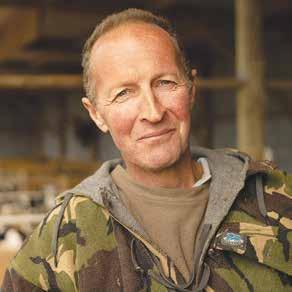
When I put these fig ures to the Associate Min ister of Agriculture Meka Whaitiri in Parliament, she tried to downplay the size of the problem, stat ing “only 6.5% of South land’s winter forage crops are at a slope of greater than 10 degrees, which is the slope maximum in the intensive winter grazing module”.
The Minister was wrong though. Figures obtained by ACT from Environment Southland tell us that approximately 2,000 properties con tain a slope of 10 degrees
and have used intensive winter grazing practices.
Councils can’t put up with the regulatory burden that is coming down the pipeline so they are implementing their own rules. Environment Southland is now allowing for a deemed permitted activity authorisation for intensive winter grazing on land between 10 and 15 degrees where all other permitted activity criteria are met.
This is proof that David Parker’s plans have not worked. He has tried to force a one-sizefits-all plan on farm ers across the country that was never going to work. Local councils and farmers are fighting back against this centralisation by doing what works for them.
This follows Southland farmers stating that they would choose to ignore the regulations because the Government has not been able to get them ready in time.
This is what hap pens when the Govern ment fails to listen. ACT has been telling Parker for months that he needed to issue an extension since
FFP regulations are yet to be finalised.
Instead, Minister Parker gave farmers the choice of planting their crops without any guar
antee of consents and risk not being able to graze them next year, or not plant their crops and create a massive animal welfare and food produc
tion issue. Farmers are choosing the third option instead. As a dairy farmer myself, I know that farm ers are best environmen talists around.

Use Bovilis BVD for 12 months of proven fetal protection1. The longest coverage available.
Exposure to BVD could mean your unborn calves become Persistently Infected (PI’s) - spreading BVD amongst your herd. It is estimated that up to 40% of dairy herds are actively infected with the BVD virus at any given time. The convenience of the longest coverage available along with flexible dosing intervals2 means you can protect this season’s calves no matter when they are conceived.
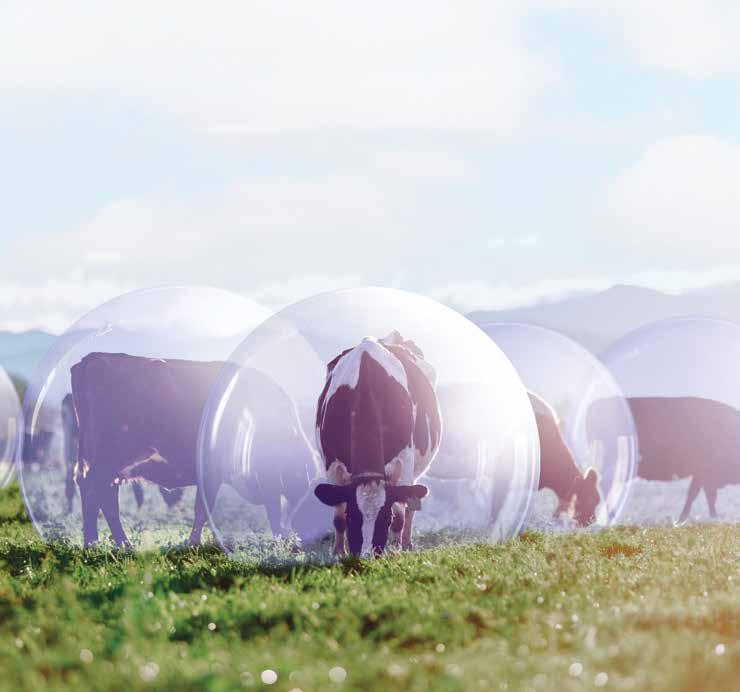
Avoid an outbreak. Ask your vet about vaccinating with Bovilis BVD or visit bovilis.co.nz
Following a third dose (annual vaccine) Bovilis BVD provides 12 months fetal protection. 2Interval between dose 1 (sensitiser) and dose 2 is from 4 weeks to 6 months. 3rd dose given as annual single dose. AVAILABLE ONLY UNDER VETERINARY AUTHORISATION. ACVM No’s: A011866. Schering-Plough Animal Health Ltd. Ph: 0800 800 543. www.msd-animal-health.co.nz Copyright © 2022 Merck & Co., Inc., Rahway, NJ, USA and its affiliates. All rights reserved.NZ-BOV-220700001







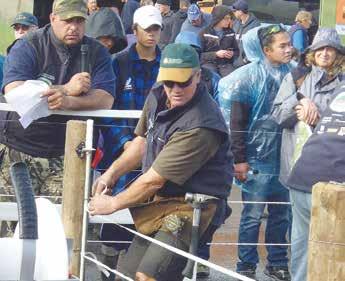



























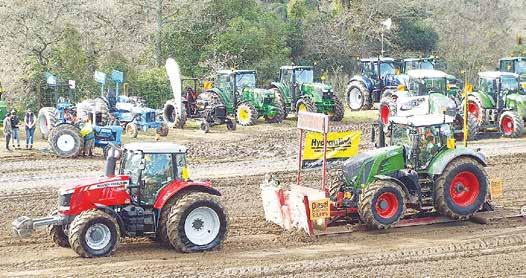








WITH ONLY two weeks before the rescheduled National Fieldays, organ isers are hoping to put the woes of Covid-19 behind them and take a positive slant into the end of 2022 and beyond.

Building on the Fiel days Society’s themes of ‘Innovation, Education and Globalisation’, chief executive Peter Nation is confident of delivering a world-class event.
“Having made the tough decision back in March to postpone Fiel days until the end of the year because of the Covid traffic light settings, we’re now nearing the finish line and the delivery of a world class event,” Nation told Dairy News

While the revised timing has brought specu lation about who will walk through the turnstiles –

with some suggesting that farmers will be too busy with harvest to get away from the farm for a day –but like any event, if you do want to go, you will make time.
Nation expects a good
turnout.
“We will very much be the same-same event, albeit with a little more sunshine and no fog. Indeed, weather records for the last ten years sug gest an average daily tem


at the end of last month, this time in selected areas, as the return to “normal ity” brought with it sev eral other on-site events at the same time. Fiel days report that there have been several logisti cal challenges, not least, sourcing enough tents and marquees, but also site contractors reporting ongoing labour shortages and still some sickness brought about by Covid.



Taryn Storey, head of customer and strate gic engagement, reports that as of early Novem ber, around 94% of avail able sites had been allocated, compared to 2021, although several long-time previous exhib

itors such as Toyota, AGCO and Farmlands had decided not to attend, citing ongoing supply chain disruption and staff shortages.

Dairy News had heard first-hand that some exhibitors were feel ing less than enthused at taking part in the same, large-scale event within a six-month timeframe, as Fieldays 2023 is sched uled to return to its tra ditional June timing. But Nation says they were approached by several large exhibitors “who asked us not to give up on holding an event in 2022”.
“We know that Fiel days is a bridge to bring ing our rural communities
back together after these difficult few years. The record numbers in June 2021 proved this, but it broke our heart to have to turn people away on the Friday.
“There’s no doubt our event is a great way for friends and family to catch up again and maybe spend a little money on the exhibitors’ sites. By the same token, we are also hearing from exhibi tors that in some cases they are shifting the emphasis from just busi ness, to welcoming their customers with light refreshments and saying thanks.”
perature of 21 degrees C, with a 30% chance of rain, so it should be a case of shorts, factor SPF 50 sun block and maybe a brolly behind the seat of the car, just in case.”
Fieldays set-up started
ALONGSIDE THE general trade stands that we have grown to ex pect, the 2022 event will see some introductions and expansions.
The new Forestry Hub will bring together more than 45 exhibitors into one marque, showcasing the impor tance of this growing industry and rather than just talking about ship ping logs to China, raising awareness of high-grade timber for structural and decorative use, furniture manu facture and as an alternative fibre source. Launched after around four years of discussions, the Forestry Hub is supported by a wide range of industry organisations, growers and manufacturers.
Likewise, an expanded Careers Hub is set to focus on current labour shortages throughout rural indus tries, showcasing career paths for youngsters or possible avenues for those looking to make a career change. Meanwhile, the Health Hub recognises that access to rural medi cal services continues to be a major
problem to those living in isolation or indeed any distance from the main centres.
Peter Nation notes, “Since we started the Health Hub, we are somewhat humbled to think we have touched over 33,000 lives. We have come across numerous stories about reluctant rural males who have been dragged into the Hub by wives or partners, who have then been shocked to find out they have issues like melanoma or diabetes that have been identified and directed to treat ment providers. There will be medi cal professionals on site to discretely help and offer advice, so we would even suggest to exhibitors that they might even give staff a half an hour off their sites, to pay a visit and get a free basic health check.”
As in previous years, The Innova tion Hub will showcase clever ideas and products from a range of sec tors, including, dairy, forestry, farm management, animal health, genet ics, horticulture and viticulture.
VISITORS TO Fieldays this year will get a taste of how cow collar technol ogy Halter works.
Halter farmer, Pete Morgan, runs a 600-cow farm in the Waikato. He will live stream the tech nology to shift his cows from the Halter Fieldays site.
While on site at Mys tery Creek, Pete will use the Halter app to remotely shift his mob in Te Awamutu. A live stream will show cow movements in real-time, starting at 2.30pm on Thursday and Friday.
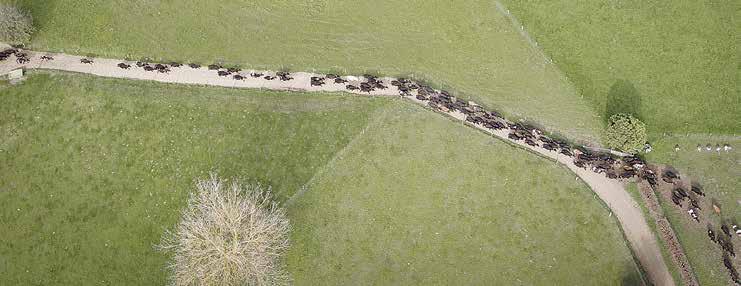
“At our farm, we are designing breaks with dif ferent shapes that opti mise exactly the accurate allocation of feed, cows move quietly at their own pace, and the farm has had a huge lift in produc tivity,” says Morgan.
“Without a doubt, Halter has changed the way we farm.”
Halter chief executive Craig Piggott is looking forward to sharing their groundbreaking technol ogy with such a wide and captive audience.
“Pete will shift his cows from Fieldays, and this is huge because he can be at Fieldays or any where really, and his farm continues to operate.
“I love seeing a farm er’s reaction to a virtual shift. It’s a look of sheer wonder as they see cows calmly moving to another break, all at their own pace.


“No dogs, no motor bikes, no walking behind cows: just a collar and a smartphone. Fieldays is a

great opportunity for us to show just how simple and life-changing it can be.”
Just like Fieldays, Waikato is where Halter began. From humble beginnings on their research farm in Mor rinsville six years ago, Halter claims to now sup ports “hundreds of farm ers and tens of thousands of cows” across New Zealand, with signifi cant uptake in the South Island.
The company says it supports farmers in unlocking the most pro ductive and sustainable farms.
“The system com bats labour shortages and improves animal health and performance by enabling farmers to remotely shift, virtu ally fence and proactively monitor the health of their cows.
“Halter also features an integrated pasture management system to help farmers get the most out of their grass.
“By leveraging realtime data, Halter auto matically calculates feed and, coupled with their virtual fencing, allows for more precise kgDM or pasture allocation per cow.
“By automating some of the most time-con suming tasks on the farm, Halter significantly reduces workloads, allow ing farmers to use their time more efficiently.”
Piggot says Halter is meeting the industry’s demand for positive and more efficient change.
Discuss how our ID, Feed, Milk Sensors and Cup Removers can add efficiency and consistency to your shed operation.
Great identification starts with permanent marking. Allflex tags handle our tough conditions, and cannot be beaten on durability.

MENT co-operative LIC is excited to meet with its farmer shareholders on stands E78 and E80 at this year’s National Fiel days.

Specialists from the coop’s genetics, herd testing,


animal health, Gene Mark, MINDA, SPACE and FarmWise teams will be available to meet with farmers and support them with their herd improve ment decisions.

LIC chief executive, David Chin, says the team


is looking forward to catching up with farmers and connecting with the industry following a busy spring season.







“Fieldays is a great opportunity for the dairy industry to come together and I’ve always enjoyed
connecting with our farm ers at the event over the years.
“I’m really looking for ward to meeting with our farmer shareholders and sharing some of the great work our team is doing to help New Zealand farm
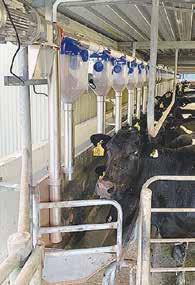
ers breed the best cows faster.”
This year, LIC will have an innovation area to spotlight its research and development pro grammes. Here, LIC’s sci entists will be sharing the cutting-edge work they have underway to support farmers to meet current and future environmen tal challenges head on, including a low-methane emitting research pro gramme, Resilient Dairy, and a heat tolerance breeding programme.
“We’re proud to be one of the largest inves tors in R&D in the pri mary sector and this year has seen some particu larly exciting results from
the programmes we have underway.
“We’re excited to showcase some of these results and the value they are delivering on farm at this year’s Fieldays,” says Chin.
The LIC site will again host a café for its farming families with complimen tary coffee, snacks and real fruit smoothies.
For those looking for their next career oppor tunity, LIC will also have a stand in the Fieldays Careers Hub where they will be highlighting some of the exciting roles they have available both in the Waikato and in other regions across New Zea land.
“We’re proud to be one of the largest investors in R&D in the primary sector and this year has seen some particularly exciting results from the programmes we have underway.”
LIC chief executive David Chin says his team is looking forward to connecting with farmers at the Fieldays.


TechNZ has released a comprehensive research report featuring insights from farmers and growers around digital technology in agriculture.
The Baseline of Digi tal Adoption in Primary Industries report high lights internet connec tivity, data sharing, plus barriers and drivers influ encing adoption.
“We managed to bust a few myths through our discussions with farm ers and growers, includ ing the idea that age is a defining reason for reluc
tance to adopt technol ogy,” says AgriTechNZ chief executive Brendan O’Connell.

“Rather than the age of the operation’s owner, it’s the stage in the business lifecycle that was more of an influence on adoption decisions.
“Additionally, although 77% of farmers and growers are happy to share their data when it provides direct ben efit to them, the results show only half are actu ally doing so. There are opportunities for every one to further investigate data clarity, confidence and defining data value.
“We strongly believe tech innovation is the enabler of progress in sus
tainable production and this report paints a pic ture of the realities on the ground across New Zea land,” says O’Connell.
Globally, there has been huge forward momentum in the past 3-5 years with the availabil ity and adoption of digital solutions.
O’Connell says their goal is to continue build ing an environment for New Zealand technology businesses to flourish and take advantage of favour able markets wherever they may be in the world.
“The future evolution of food production is crit ical, not just locally but on the global stage.
“Through a dynamic and advanced Agritech
ecosystem, New Zealand farmers and growers can also take advantage of any new innovations on offer and be at the forefront of industry developments,” says O’Connell.
The report is pub lished with support from the Ministry for Pri mary Industries, DairyNZ, Foundation for Arable Research, Fertiliser Asso ciation and Zespri Inter national Ltd.
It investigates five Pri mary Industry sectors –dairy, horticulture, arable, sheep and beef.
Download the report from the AgriTechNZ website – www.agritechnz. org.nz
@dairy_news facebook com/dairynews
NZ LANDCARE Trust and Westpac have announced a partnership to help community groups improve water ways around the country.
The Westpac Watercare Project will see six $10,000 grants handed out each year to conservation proj ects. Westpac will provide the fund ing and work with NZ Landcare Trust to distribute it.
The Trust works within regional communities to support sustainable land and water care initiatives and projects throughout New Zealand.
NZ Landcare Trust chief execu tive Dr Nick Edgar says the partner ship will help local groups take action
on key issues affecting our waterways.
“Many of our catchment areas are suffering from declining biodiver sity, excess sediment buildup or poor water quality,” Edgar says.
“We have roughly 106 catchment groups, 11 catchment collectives and 377 community Landcare groups, all of whom need varying degrees of support and funding to keep up their great work.
“With Westpac on board, they’ll be better-equipped to make practical and positive changes to their local envi ronment. That could involve planting native trees, weed control, trapping more pests, or investing in water-
monitoring equipment, among other important initiatives.”
Westpac NZ head of agribusiness Tim Henshaw says the bank is com mitted to helping protect and enhance our awa (waterways) for the benefit of all communities.
“We all want to do our bit to look after our backyard. By supporting the Trust’s important work at the grass roots level, we’re helping everyday New Zealanders make a real differ ence in their area and contributing to a cleaner and healthier environment,” Henshaw says.
“With more than 5,000 staff around the country, we already have
a strong footprint in the regions, and this partnership will give our people opportunities to volunteer on proj ects, working hand in hand with local communities.”
The Eastern Whio Link, which aims to restore whio (blue duck) pop ulations to East Coast rivers through extensive stoat trapping, recently became the first group to receive the $10,000 grant. Westpac ambassa dor Richie McCaw spent time work ing with the team near Gisborne last week and was impressed by their pas sion and dedication.
“It was great getting my hands dirty with some really committed
locals and seeing their amazing work up close,” he says.
“For your average New Zealander, it can be hard to know where to start when it comes to conservation and cleaning up our environment, so it’s really cool to see Westpac working with local environmental groups to give everyone a chance to make a real difference.”
Five more recipients of the $10,000 grants will be announced in the coming weeks. Registrations for the 2023 Westpac Watercare Project will open next April. Groups can reg ister their interest for a grant at www. landcare.org.nz/who-we-work-with

A RECORD number of young bulls have joined LIC’s elite bull teams this spring, with twenty-seven bulls making the cut and ready to help sire the next
generation of profitable and efficient dairy cows.
The 2018-born bulls secured their spot in the team after their supe rior performance, that
was predicted by genom ics, was validated by herd testing data from their first crop of daugh ters which are now being milked on farms across
the country.
LIC Livestock selec tion manager, Simon Worth, says the co-op’s continued investment into genomic science is
helping to drive profitabil ity on farm by identify ing elite artificial breeding sires at a young age.
“With genomics we combine a bull’s DNA and
ancestry information to get a more reliable predic tion of its performance at a young age. We’ve been investing and refining the use of genomics in our breeding programme for decades, and this year’s graduation rate is a tes tament that this cuttingedge science is delivering results and predicting star performers with accu racy.”
Worth says this time of year is always a high light for his team who are responsible for LIC’s breeding scheme; from the contract mat ings through to selecting young bulls to join the coop’s Sire Proving Scheme.

“It’s a phenomenal graduation rate, there’s no doubt about it. We’re really pleased that these selected graduating bulls were sired by 17 differ ent bulls so in addition to turbo-charging the genetic merit of our Premier Sires teams, they’re also ensur ing genetic diversity.”
Worth says being selected for a Premier Sires bull team is no easy feat. “The bar is set extremely high, and rightly so. When we select our bulls, it’s first and foremost about how they rank on Breeding Worth (BW). If they tick that box, we then assess them for a range of other traits farmers are looking for in their cows.
“The addition of these bulls is based on extreme indexes, and a balance of production efficiency, udder conformation and management traits that help farmers breed better cows.”
Worth says using elite bulls to sire the next gen eration of replacements is an important tool to help farmers tackle climate challenges.

“Breeding the best cows, faster is key to help ing farmers remain prof itable and sustainable. A strong focus on herd improvement and consis tent use of high-BW bull teams will deliver results on-farm by breeding cows that produce more and are more emissions effi cient.”
Worth says not only did this year’s Spring bull graduates break an LIC record, they also made an impact on the industry’s Ranking of Active Sires (RAS) list, which ranks bulls from all breeding companies according to their Breeding Worth.
Of the top-30 bulls across all breeds*, 13 are the co-op’s new Spring bulls with two of the new graduates occupying the number one and two spot – KiwiCross bulls Gor dons Flash-Gordon and Schraders Trader.
Dairy herds across the country will be using these genetically superior young bulls for mating now through LIC’s range of Premier Sires bull teams.
“The beauty of our fresh semen service means we can select a bull to join a team one day and his genetics can arrive on-farm the next day for insemination, so we can deliver that genetic improvement onfarm almost immediately for farmers to capital ise on.”
so are my breeding decisions.”
CRV myDNA product manager

cific traits they needed to boost the performance of their animals. The next step was genomic testing.




This more reliable genomic infor mation can dramatically change the breeding decisions a farmer makes.”


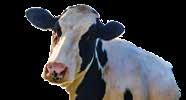



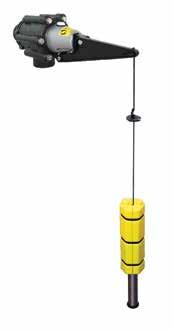
DEMAND FOR an
award-winning diagnos tic tool launched seven years ago to analyse and manage clinical mastitis is growing, according to Farm Medix.

Snapshot was devel oped by Farm Medix to identify pathogens in the bulk tank, and establishes why they are present.




The New Zealand company, which started

operations in 2011, first launched a diagnostic tool in 2015 to analyse and manage clinical mastitis.

“We rapidly realised that our offer could pro vide better results to

farmers. With a proactive approach, we can deter mine the root causes of mastitis infections at farm level,” says Farm Medix chief executive Foucauld Thery.
He explains that clin ical mastitis is more a symptom than an illness. To cure the disease, the farmer needs the whole picture. A study published in 2017 by The Journal of Dairy Science has shown that 70% of clinical mas titis cases do not require treatment.

Treatment is not always the better option: process changes, equip ment settings, teat care active ingredients, milking procedures are among the areas that can make the difference.
“If you know where to look, you will find many successful, quick and cheap fixes,” says Nata sha Maguire, Farm Medix chief scientific officer.
“The doubling of our Snapshot activity this year alone is a testament to the effectiveness of this comprehensive approach,” she says.
Maguire says to opti mise impact, mastitis management must be adapted to the pathogens.
“Usual suspects like Strep. uberis, Staph. aureus, E. coli, are bacte ria that require specific approaches.
“Also, algae like pro totheca, or a fungi like candida are not cured by antibiotics. All of them are proven sources of high SCC levels.”
Maguire says somatic cell count measures an immune response. It does not indicate the cause of the infection and there fore cannot be relied upon for treatment deci sion.
Side-by-side analysis of SCC based interventions and systematic identifica tion of pathogens made by Farm Medix confirms a gap.
“All our studies find Staph. aureus cows with low SCC. This October, we identified 44 cows with Staph. aureus below 150 SCC in a herd of 344. It means that no SCC cutoff works,” she says.
Mastitis usually results from multiple contribut ing factors. If not anal ysed correctly, problems can last for years.
“We have established successful and long-term partnerships with farm ers to proactively monitor and reduce their mastitis.
“Clinical mastitis is the visible part of the ice
berg. What drives high SCC levels and clini cal cases is the subclini cal picture – the insidious infections you don’t see.
“For Staph. aureus infections for example, 95% of cases are subclin ical. Studies show they have huge impacts includ ing elevated bulk tank SCC level and fertility.”
Herdscreen, another service, was designed by Farm Medix as a fast and economical way to iden tify Staph. aureus cows. The traditional approach, herd testing, is statisti cally based and lets conta gious cows can spread the infection, potentially lead ing to healthy cows being unnecessarily culled.
Maguire says with this approach, the company’s impact and reputation has grown with Farm Medix winning multiple awards such as the KuDo’s Sci ence Excellence Awards in 2015, 2017, and in 2019, the Food and Agricultural Science Award.
Mastitis is the number one problem for dairy farmers costing the aver age New Zealand farmer (milking 435 cows) $80,000 per year.
said to ensure a secure grip and high clamp ing force when moving heavier and difficult mate rial.
AS WE move into spring, Kubota New Zealand is expanding its range of with the addition of the Land Pride Claw Grap ples.
Designed for frontend loader mounting, the clever attachment allows easier handling of loose bulky material that can be awkward to pick up with a standard bucket.
The Land Pride SGC Grapple range is designed to fit Kubota compact and sub-compact tractors, with tines manufactured from AR400-grade steel, making it lightweight, yet extremely durable. Dual hydraulic cylinders are

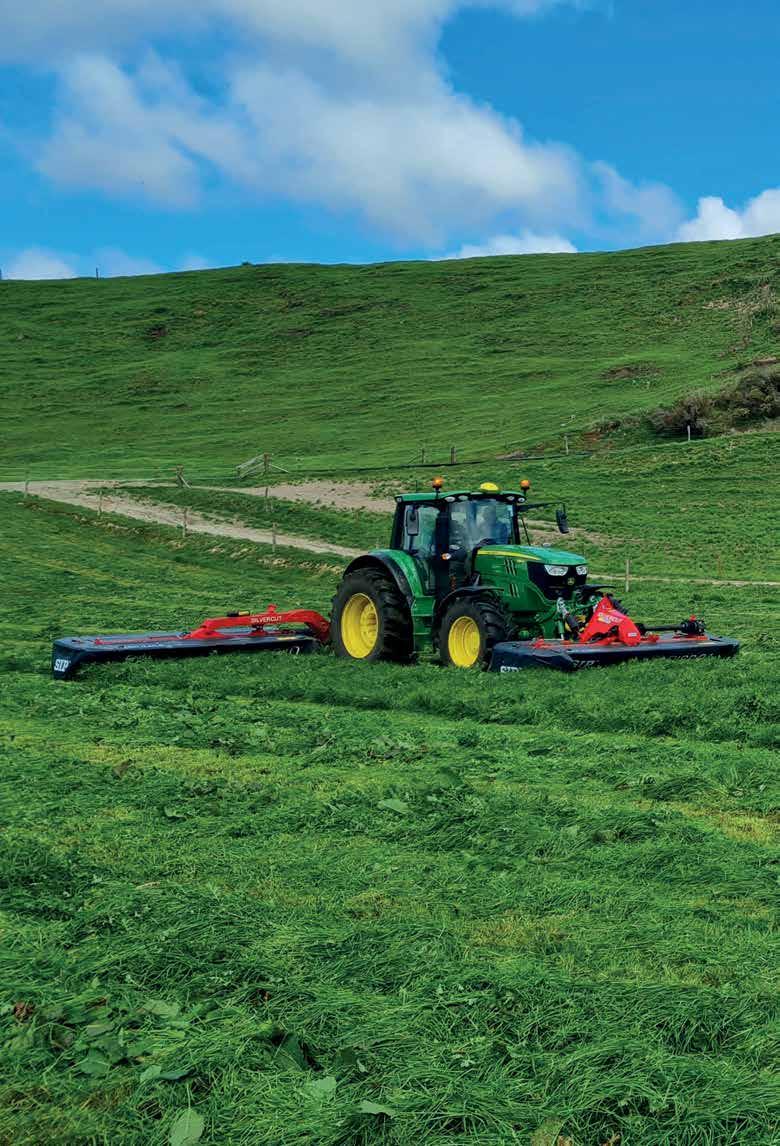
The SGC range for the New Zealand markets consists of four models, with the SGC0548 at 1.2m-wide, made specifically for BX Series tractors with pin-on attachment, while the larger SGC0660 is 1.5m wide with a universal quick-attach hitch, making it suitable for tractors up to 40hp. For tractors in the 30-55hp range fitted with a universal quick attach hitch, the 1.5m SGC1060 or 1.8m SGC1072 will provide a heavier duty option.

Said to be suitable for a diverse range of jobs
such as moving rocks, trees, brush, and con struction debris without picking up dirt, or just looking to rake and dig, the SGC range can allow operators to easily grasp, lift, and move a variety of materials.

NORWOOD HAMILTON, the importer-retail er’s newest dealership, located in the heart of the Waikato, is focused solely on the KUHN brand.
The only Norwood retail store dedicated to a single brand, it will operate alongside longstand ing KUHN outlets Whyteline (based in Paeroa) and Roger Gill Agriculture (based in Huntly).
The unique approach is designed to allow farm ers and contractors direct access to dedicated KUHN product experts, says Tim Fanning, executive leader, network operations.
“Our product specialists are factory trained experts who only deal with KUHN equipment, mean ing they know how to get the best from the product, alongside being able to quickly diagnose and address any performance issues in the field,” says Tim.

Located on Ossie James Drive, Rukuhia, adjacent to Hamilton Airport, an extensive range of mowers, rakes, tedders, spreaders, and balers are on display and ready for sale.
“It’s been exciting to see this new outlet coming together,” says Deane Hughes, Norwood Hamilton manager.
“We’re fully stocked and prepared for the upcom ing season with machines for sale and importantly we are also stocking over 600 lines of genuine KUHN parts. Our customers work hard and so does their equipment, so we’re here to offer the best product knowledge and timely support, something this new approach is designed to deliver.” – Mark Daniel
AT

taya Special; a pneumatic, mounted seed drill, with a working width of 3m and hopper sizes of 1,000 or 1,500 litres capacity.


Destined to replace the AD-P Special, seed drill



can be equipped with the RoTeC single disc coulter or with the TwinTeC Spe cial double disc coulter.
Featuring a segmented distributor head, the layout mounted behind


the seed hopper ensures a short travel distance for the seed, while the for ward positioned hopper offers an optimal centre of gravity close to the tractor. The distributor


head is easily accessed via the loading board for checking during drilling.
The low profile of the hopper also gives the driver a better overview of the machine, with the 2.3m wide x 0.84m hopper filled easily from big bags, front end loaders, or small sacks. Steep hopper walls guide the seed corn down to the metering unit and only small residual amounts are left in the hopper.
Controlled via ISOBUS, in-house devel oped AMAZONE software allows intuitive operation, working in conjunction with the TwinTermi nal, the machine can be quickly set up for drilling.
Calibration of the seed hopper can be carried out from the loading board, accessing the metering unit on the bottom of the hopper, with seed gath ered in the collection bag supplied and weighed using the scales that are
also provided.
For other seeds, or dif ferent seed rates, AMA ZONE offers a variety of different metering cas settes for the Centaya Special, only requiring two bolts to be released on the metering unit using the tool supplied.
The unit can be equipped either with the RoTeC single disc coul ter or with the TwinTeC Special double disc coul ter. The former is mainte nance-free and can work where large amounts of straw and plant residues are present featuring a 12.5 or 15cm row spacing.
The sowing disc and a furrow former create the seed furrow profile and provide optimum seed placement into the soil. The TwinTeC Special double-disc coulter offers a precise and sturdy fit ment, with a disc diame ter of 340mm and coulter pressure of 40kg, said to be ideal for higher speeds.

TURER Major Equip ment Intl Ltd has appointed Taranaki-based AgriQuip as its distributor of Major branded prod ucts in New Zealand.

AgriQuip supplies a network of tractor deal erships throughout the country, offering service and after-sales support in the North and South Islands.
“Major has a trusted reputation around the world for top qual ity, durable machines,” says Mark Hamilton at AgriQuip.
“The design and engi neering of their grasscutting range is just
excellent. Our custom ers are always looking for hard-working machinery that can cope with New Zealand conditions and Major products fit the bill.”
AgriQuip will stock the Cyclone rotary shred der in working widths from 2.0m to 6.3m. Said to deliver the perfor mance of a bat-wing or flail shredder with half the fuel and power require ments, the Cyclone is ideal for grassland main tenance, vegetation man agement and equally adept at clearing over grown land.
In addition, the New Plymouth-based company will also provide a selec tion of Major Groundcare machinery including the Swift Roller Mower range,

FOLLOWING ITS acquisition of the Lely grassland business, Fendt, part of the global AGCO group, has invested €20m (NZ$34m) at its Wolfenbuttel factory in Lower Saxony.
It has also announced that the facility is now fully operational for the production of both round balers and Tigo forage wagons.
Following the takeover in 2017, the formally known Welger Werke had a history of agricultural engineer ing, particularly balers, dating back around 123 years.
Manufacture of loader wagons started in Septem ber with all models of the Fendt range being assem bled in a newly equipped 4,200m² production hall. A further 10,000m² of logistics space has also been added to support the loader wagon assembly.
Despite the industry suggesting the market for loader wagons was at best static, with major player Claas withdrawing from the sector earlier in the year, Christoph Groblinghoff, chairman of the Fendt man agement board, commented, “Because the market for loader wagons is manageable worldwide, we want to, and must, build the best loader wagons for our cus tomers”.
“With the expansion of the Wolfenbuttel site, we are investing both in a state-of-the-art development location for engineers and in a modern production location to ensure quality in development and pro duction.”
This would suggest that the company believes the future of loader wagons is likely to remain a small but steady market, so it is a question of gaining market share with a much greater attention to detail engi neering and ongoing product development.
During the factory upgrades, the works were com pletely gutted and a new single line for the balers installed, which, through process optimisation, has allowed all the balers to be produced on the same production line. The same strategy has been applied to the loader wagon assembly line with eight ranges and 25 models available. The investment has also cre ated employment for a further 60 staff.
the Contoura mower for golf and sports grounds, and the CS Pro for Com pact Tractors. www.agriquip.co.nz
“We use it for everything; it’s a multiuse machine. And it’s simple to use - we looked at other machines, but this was just so simple to use, and user-friendly for staff as well.”- John Whittington, Dairy Farmer, Taranaki
